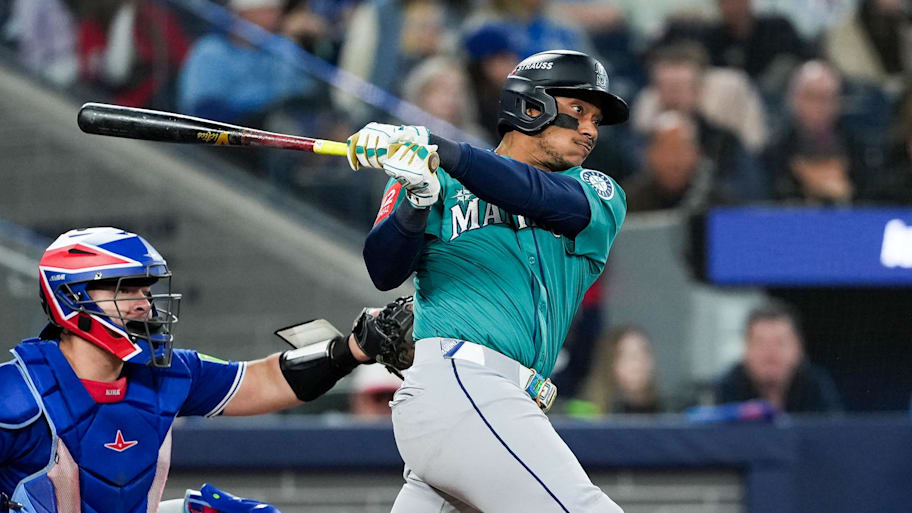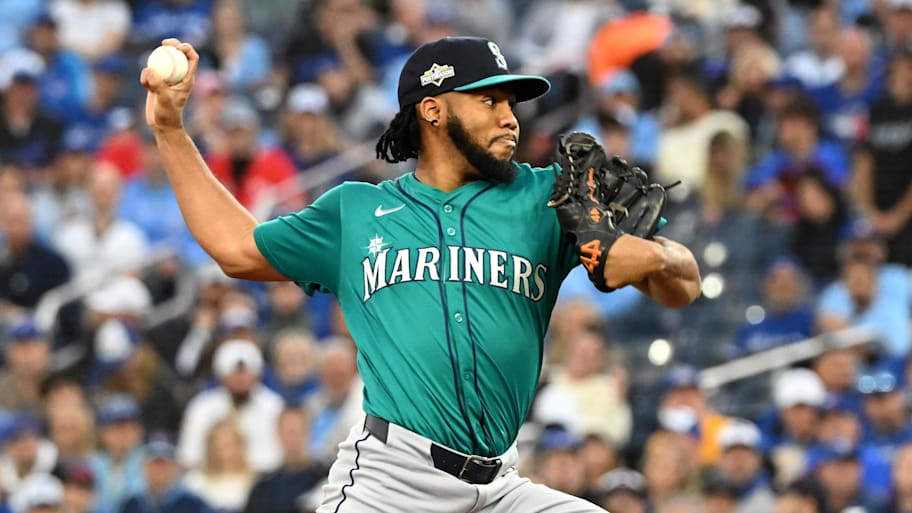
TORONTO — The biggest scare for the Seattle Mariners in two ALCS games in the former hotbox known as Rogers Centre had nothing to do with fastball crusher Vlad Guerrero and his mighty Blue Jays, who had just slugged .601 in sending the New York Yankees home. It was the sight of their irreplaceable foundational player splayed face down on the turf between the mound and home plate.
It was the fourth inning of ALCS Game 2, tied 3–3, when Mariners catcher Cal Raleigh, after completing a difficult and quick-footed play on a swinging bunt, took his pratfall. If the length of time he was prone was even one or two seconds, it was an eternity to the Mariners, who rely on Raleigh more than any team relies on any one player.
“Jammed my wrist,” Raleigh said. “As I went to land, I put my [glove] hand out like this”—he held his hand out palm down—“and it rolled under like this”—he curled the back of his wrist to the floor. “I’m good. All’s good.”
Everyone in Seattle exhaled when Raleigh got up and, after brief inspection from a trainer, stayed in the game.
All’s good, indeed. The Mariners boatraced Toronto after that scare, winning 10–3 to put the franchise in the best position it has ever been in to go to its first World Series: up two games to none with the next three games at home.
Raleigh influences another game-changing moment
Once again, all things good for the Mariners went through Raleigh. It was partly because Toronto manager John Schneider was so terrified of Raleigh that with a runner at second base he intentionally walked him—in the fifth inning of a tie game with no outs!
No one has ever taken such an avoidance procedure in the postseason quite like that one. Only three times in postseason history did a manager intentionally walk a batter with no outs in a tie game as early as the fifth inning, but they all came with runners at second and third:
- In the 1958 World Series, Braves manager Fred Haney walked Mickey Mantle in the first inning.
- In the 1981 World Series, Yankees manager Bob Lemon walked Rick Monday in the fifth inning.
- In the 2009 NLDS, Dodgers manager Joe Torre walked Albert Pujols in the first inning.
Not only did Schneider hand Seattle another baserunner (who would score, thank you) but he also pulled rookie phenom Trey Yesavage to go to reliever Louis Varland.
“Velo went down a little bit as he went,” Schneider said. “I think that was the biggest thing. Had the three strikeouts but [he] wasn’t getting as much swing-and-miss. That was the biggest thing.”
Two batters later, Jorge Polanco, Seattle’s Señor October, blasted a three-run homer from which Toronto was never going to recover. Polanco has knocked in the game-winning run in three straight games, becoming the first player to have a go-ahead hit in the fifth inning or later in three consecutive postseason games.
JORGE POLANCO IS JUST RIDICULOUS! #ALCS pic.twitter.com/vkairlteWX
— MLB (@MLB) October 13, 2025
The win also went through Raleigh because he is the pitch-caller extraordinaire for Seattle. He and his band of strike-throwing, let-it-eat pitchers have pulled the plug on Toronto’s power, holding the Jays to one solo homer in two games and, incredibly, one hit in 42 at-bats (.024) after the second inning. Seattle’s pitchers are harder to read than James Joyce.
“It’s all about mixing it up,” Raleigh said. “Keep giving them different looks. It’s the postseason. Everybody’s got scouting reports. They have really good hitters over there. So, it’s about staying away from patterns. We try the best we can to give them different looks.”
Mariners’ staff depth, strike throwing continues to pay dividends

Seattle led the AL in strike-throwing during the season (65.3%). It has been even better at the task in this series (66%). Meanwhile, the Mariners are throwing more secondary pitches in the postseason (50%) than they did in the regular season (league-low 44.5%).
There is a familiar pattern to Seattle’s postseason games: managers have been quick to get their best pitchers out of the game against them (Tarik Skubal twice under 100 pitches, Kevin Gausman and Yesavage each in the fifth inning), only to learn that they don’t have the cache of elite arms behind them to match against Seattle’s deep core of outlier arms, be it Eduard Bazardo’s power sinker or the sliders of Matt Brash and Andres Muñoz. Those right-handed power arms have a combined 1.80 postseason ERA over 20 innings.
Manager Dan Wilson doesn’t worry too much about matchups, other than having Gabe Speier on the other team’s best lefty hitter in a close game third time through. Mariners pitchers trust their stuff, and they trust Raleigh.
Seattle pitchers pound the strike zone early and expand when ahead. They are blunter than they are covert in their approach. For instance, they hardly bother with dabbling in cutters, the fake-fastball option designed to move the baseball off the barrel in traditional fastball counts. They were 27th in cutter use in the regular season. They have thrown only 38 cutters in seven postseason games, all by low-leverage pitchers Carlos Vargas and Caleb Ferguson.
“Ask any catcher,” Raleigh said, “and they will tell you that the greatest joy in the game comes from calling a game, running a staff, game-planning against good hitters and executing the plan. And what we’ve done best in this series is execute the plan.”
The postseason is about avoiding slug. The Mariners have done so without compromising their greatest strength: throwing strikes.
Said Schneider, “Slug hasn’t been there for us. [It] has been there for them, and you never know when it’s going to turn. They’ve got a good pitching staff. They’re featuring some good stuff.”
Most importantly, the Mariners have taken Guerrero off the board as the preeminent game piece of Toronto. Guerrero is 0-for-7 in the series, including six groundball outs.
Why is it working? Against the Yankees in the ALDS, Guerrero went 3-for-3 against lefties Max Fried and Carlos Rodon. The Mariners have no lefty starters and only one high leverage lefty. Guerrero has seen only righthanders against Seattle, all with pitch shapes to throttle him: the four-seam ride of Bryce Miller, the slider of Muñoz, the slider/sweeper/fastball carousel of Logan Gilbert and the running sinker of Bazardo.
The Blue Jays are in a world of trouble. To save their season they must win at least two of three games at T-Mobile Park, where since July 31 the Mariners are 25–7. The more decisive location, however, is the 60 feet, six inches between the mound and home plate. In that narrow band, the Jays are getting out-stuffed and out-smarted by the Mariners.
More MLB on Sports Illustrated
This article was originally published on www.si.com as Mariners Have Blue Jays Right Where They Want Them.







